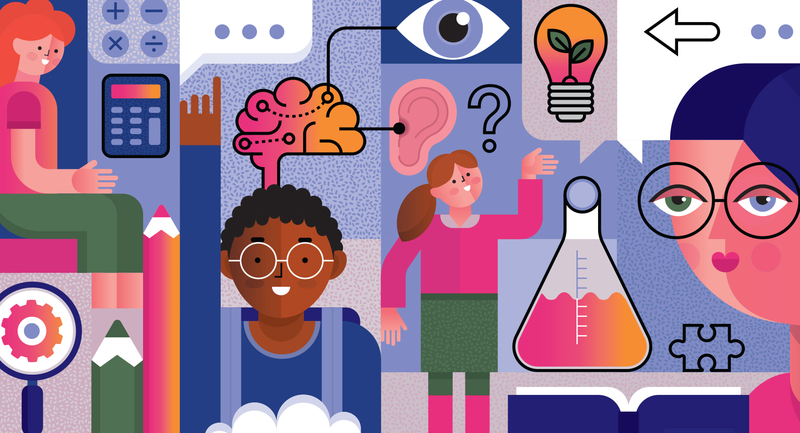The #DisruptTexts Twitter chat isn't afraid to put classic texts in the hot seat. The titles addressed would ring familiar to most students, past and present: Lord of the Flies, To Kill a Mockingbird, The Crucible. As educators discuss how best to teach (or not teach) these books in week-long Twitter chats, one title at a time, they call out the perils of a K–12 literary curriculum long set in stone. All children deserve to see themselves and their experiences reflected in books, but too many students, especially students of color, are denied such opportunities. White-authored "classics" still dominate the top 10 most-read lists for high schoolers, according to research from assessment company Renaissance Learning. What's more, diverse literary perspectives face a multitude of challenges to exposure. Of the 416 books flagged for questionable content in schools and libraries in 2017, the American Library Association's Top Ten Most Challenged Books list includes titles by black authors (Angie Thomas's The Hate U Give) and books that discuss Islam (The Kite Runner by Khaled Hosseini) and LGBTQ experiences (George by Alex Gino). For decades, scholars have decried the harmful disconnect between young, diverse readers and the mostly white, middle-class, straight, and able-bodied characters and storytellers they engage with in the classroom. In her 1990s essay "Mirrors, Windows, and Sliding Glass Doors," scholar Rudine Sims Bishop wrote that when students see images of themselves that are absent, negative, or distorted, "they learn a powerful lesson about how they are devalued in the society." Decolonize the Curriculum
The founders of the #DisruptTexts movement—English educators Tricia Ebarvia, Lorena Germán, Kim Parker, and Julia Torres—offer a new set of tools to create a more equitable ELA curriculum through recurring chats and a crowdsourced website of resources. They started the hashtag in 2018 to center perspectives of marginalized voices, especially people of color, in student literature. They now present on #DisruptTexts at gatherings such as the National Council of Teachers of English conference and Teachers College's Social Justice Saturday.
"We have a lot of power over what and who we bring into the classroom," said Ebarvia. "Collectively, we have an opportunity to make real change."
The benefits of disruption are wide-ranging: Research has shown that diverse literature reduces stereotypes and increases empathy, global awareness, and academic performance among all students. Absent districtwide shifts in curriculum, teachers can choose which books to highlight and how to frame literary discussions to better reflect the needs and experiences of every student. Individual awareness is the first step to challenge traditional, whitewashed pedagogy and prevent damaging experiences for readers of color. The #DisruptTexts model asks teachers to audit their personal and classroom reading experiences:
What experiences have shaped and limited your ideas about race, culture, gender, and power?
How inclusive are the books and media you consume personally and professionally?
How inclusive are your class discussions and curricula?
Teachers can then employ two main levers of disruption: the diversity of the texts they choose and the critical pedagogy they use to guide students' engagement with the texts. That might mean using pairings and counternarratives to champion missing voices or replacing texts with alternative titles. Last year's #DisruptTexts chat about The Great Gatsby suggested teaching the text alongside Ta-Nehisi Coates's Between the World and Me, Harlem Renaissance poetry, and the film Beasts of the Southern Wild. Empower Students
Any text is prime for disruption, but the movement's founders caution that it isn't just about replacing older texts with newer ones—it's a professional responsibility to both focus on marginalized voices and develop students' critical literacy skills to question the status quo.
Parker works with preservice teachers in Massachusetts to design inclusive units, thinking critically about how to teach about Christopher Columbus using voices of American Indian scholars like Debbie Reese. Ebarvia, who teaches at Conestoga High School near Philadelphia, asks her students to examine national identity in novels like The Things They Carried. In an account of the Vietnam War, why do they hear military voices but not Vietnamese or civilian ones?
To frame discussions of any book, educators should think about the following questions alongside students:
Whether her students devour The Poet X or Othello, Torres—who teaches in a predominantly black public high school in Denver with majority-white colleagues—always keeps in mind: How is this story empowering or disenfranchising students?
"As educators of color, this work is something we do as a means of survival," said Torres, a teacher librarian. "All of us teach in different environments, but all of us have the experience of going to school and not reading stories that reflected our cultural and linguistic realities and beliefs. It was very natural for us to want to create a better experience for our students—helping them reclaim what has been stolen from them."
Lean into Discomfort
#DisruptTexts isn't the only social media movement working to address holes in ELA curricula. Joel Garza, the cofounder of #THEBOOKCHAT, uses his chats to create "units in a box" for titles like There There by Tommy Orange, a novel that investigates American Indian identity. "Whether it's #DisruptTexts or #APLitChat or #TeachLivingPoets, these self-selecting groups are reading deliberately and tweeting naked," said Garza. "You don't recognize how siloed you've been until you reach out on social media."
Educators can use these online resources to track harmful patterns that might influence their approach to disruption, such as depictions of diverse characters only as victims of violence. Pernille Ripp, founder of Global Read Aloud, uses sources like #DisruptTexts, #WeNeedDiverseBooks, and Teaching Tolerance to consistently check in with her curricular choices. An audit of a book's themes and messages is just as important as title and author choices. Ripp once heard a 7th grader ask, "Why are the books that look like me always about slavery or civil rights?" "If the only books we're sharing are about basketball and brutality, then it's no better, because those aren't the only stories out there," Ripp said. "Look at the small details: What kind of experiences are you creating for students?"
But challenging a school's literary choices can be uncomfortable for some educators. In a profession where 80 percent of teachers are white, it's easy to default to the dominant discourse. That's why long-term disruption, according to Torres, will require shifts throughout departments and in professional development, not just isolated action. Part of that work involves white educators confronting both their whiteness and schools' unequal balance of race and power. "Educators are really good at having conversations and sometimes not as good about pushing back," said Torres. "This canon has been so calcified and white for so long and remains for a lot of reasons. What I will trust more than anything is when children say, 'My year was completely different.'"
Disrupt for the Next Generation
Germán, who works at Headwaters School in Austin, Tex., has seen disruptive literacy conversations begin to change school culture. Many of her high school students weren't used to talking about race, bias, and privilege. Now they call each other out on problematic behavior and language and bring up diversity issues at soccer practice, in student council, and in other classes.
That the school is undergoing an inclusive climate assessment and just hired a black male administrator isn't a coincidence, said Germán. She believes the changes correlate directly to the growth of students.
"If things proceed as they have been always, a lot of my students are going to be the folks in power," said Germán. "How do you continue to teach the same thing when our society and demographics have changed? This is where real life and fiction intersect."
This story has been updated to better reflect Headwaters School's efforts.
Disrupting in Action: The Great Gatsby
F. Scott Fitzgerald's seminal work is a common pick for high school English classrooms. For some teachers, the value of The Great Gatsby lies in its critique of American society and privilege. But when a single text becomes synonymous with the "American Dream," we should ask: Whose American dream are we talking about? Follow these steps from #DisruptTexts' Twitter chat to disrupt Gatsby:
When I teach the 1920s, the majority of my students know jazz, flappers, automobiles. What they don't know … the nativism, the visibility of the Ku Klux Klan, the lynchings, the race riots. My students come in with this idea that the Roaring 20s was a gas. Fun, frivolous, free. But for who? —@jennphillipstx
Ernesto Quiñonez's Bodega Dreams is a great companion/alternative to Gatsby. Loosely based on the Fitzgerald novel, set in East Harlem in the 1980s and 1990s.—@JMFall
A great YA lit title is Mitali Perkins's You Bring the Distant Near to look at the American Dream, reinvention of self, and identity through three generations of women in an Indian American family. —@triciaebarvia
Gatsby is the only required book in 11th grade. I pair it with The Warmth of Other Suns and a documentary about The Osage Tribal Murders. Our final essay question is, "What does it mean to be American, and who gets to be American?" —@dk_finley
You could split class into two groups: one that focuses on racial passing and the other on gender passing. I think of women who passed in order to join the military or African Americans who passed in order to survive/succeed. You can then tie it back to Gatsby and explore how his white male privilege allowed him to get to his success. —@nenagerman
One guiding question I had for Gatsby was, "If this is a story of the American Dream, what voices are being left out or misrepresented?" I used Harlem Renaissance poetry and critical reading of Wolfsheim's character to frame discussions. —@MrHorneland
Often I see Gatsby taught through the lens of the Roaring '20s—all flash and fun and fame. Disrupt that with August Wilson's Ma Rainey's Black Bottom, which takes place in 1920s Chicago. Wilson always gives a stern dose of reality without sparing your feelings. —@Lyricalswordz
At the risk of sounding radical, I don't think Gatsby is so marvelous a teaching tool that the aesthetic or style components couldn't be found in another text. Also, the Rags to Riches theme toes the line of perpetuating the myth of meritocracy. —@juliaerin80








